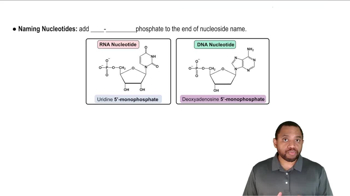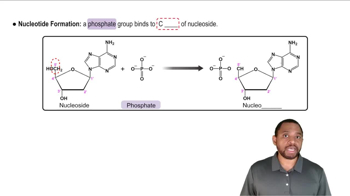Here are the essential concepts you must grasp in order to answer the question correctly.
Metabolic Nucleotides
Metabolic nucleotides are organic molecules that serve as the building blocks of nucleic acids (DNA and RNA) and play critical roles in cellular metabolism. They consist of a nitrogenous base, a sugar, and one or more phosphate groups. Understanding their structure and function is essential for grasping how they contribute to energy transfer and signaling within cells.
Recommended video:
Naming Nucleosides and Nucleotides Concept 2
Riboflavin
Riboflavin, also known as vitamin B2, is a water-soluble vitamin that is crucial for energy production and the metabolism of fats, drugs, and steroids. It serves as a precursor for the coenzymes flavin mononucleotide (FMN) and flavin adenine dinucleotide (FAD), which are vital for various enzymatic reactions in the body. Its presence in metabolic nucleotides indicates a link between vitamins and nucleotide metabolism.
Nucleotide Structure
Nucleotides are composed of three main components: a nitrogenous base (adenine, guanine, cytosine, or thymine/uracil), a five-carbon sugar (ribose or deoxyribose), and one or more phosphate groups. The specific arrangement of these components determines the nucleotide's function and its role in cellular processes, including energy transfer (as in ATP) and the synthesis of nucleic acids.
Recommended video:
Nucleoside and Nucleotide Formation Concept 2
 Verified step by step guidance
Verified step by step guidance Verified video answer for a similar problem:
Verified video answer for a similar problem:


 2:39m
2:39m